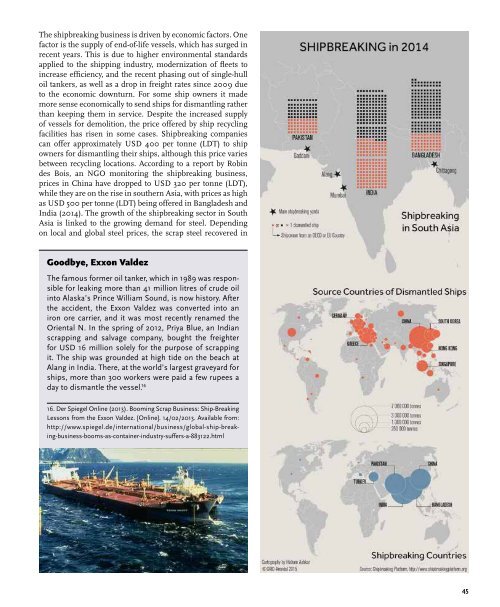WASTE CRIME – WASTE RISKS
6VhhXcA80
6VhhXcA80
You also want an ePaper? Increase the reach of your titles
YUMPU automatically turns print PDFs into web optimized ePapers that Google loves.
The shipbreaking business is driven by economic factors. One<br />
factor is the supply of end-of-life vessels, which has surged in<br />
recent years. This is due to higher environmental standards<br />
applied to the shipping industry, modernization of fleets to<br />
increase efficiency, and the recent phasing out of single-hull<br />
oil tankers, as well as a drop in freight rates since 2009 due<br />
to the economic downturn. For some ship owners it made<br />
more sense economically to send ships for dismantling rather<br />
than keeping them in service. Despite the increased supply<br />
of vessels for demolition, the price offered by ship recycling<br />
facilities has risen in some cases. Shipbreaking companies<br />
can offer approximately USD 400 per tonne (LDT) to ship<br />
owners for dismantling their ships, although this price varies<br />
between recycling locations. According to a report by Robin<br />
des Bois, an NGO monitoring the shipbreaking business,<br />
prices in China have dropped to USD 320 per tonne (LDT),<br />
while they are on the rise in southern Asia, with prices as high<br />
as USD 500 per tonne (LDT) being offered in Bangladesh and<br />
India (2014). The growth of the shipbreaking sector in South<br />
Asia is linked to the growing demand for steel. Depending<br />
on local and global steel prices, the scrap steel recovered in<br />
Goodbye, Exxon Valdez<br />
The famous former oil tanker, which in 1989 was responsible<br />
for leaking more than 41 million litres of crude oil<br />
into Alaska’s Prince William Sound, is now history. After<br />
the accident, the Exxon Valdez was converted into an<br />
iron ore carrier, and it was most recently renamed the<br />
Oriental N. In the spring of 2012, Priya Blue, an Indian<br />
scrapping and salvage company, bought the freighter<br />
for USD 16 million solely for the purpose of scrapping<br />
it. The ship was grounded at high tide on the beach at<br />
Alang in India. There, at the world’s largest graveyard for<br />
ships, more than 300 workers were paid a few rupees a<br />
day to dismantle the vessel. 16<br />
16. Der Spiegel Online (2013). Booming Scrap Business: Ship-Breaking<br />
Lessons from the Exxon Valdez. [Online]. 14/02/2013. Available from:<br />
http://www.spiegel.de/international/business/global-ship-breaking-business-booms-as-container-industry-suffers-a-883122.html<br />
45


